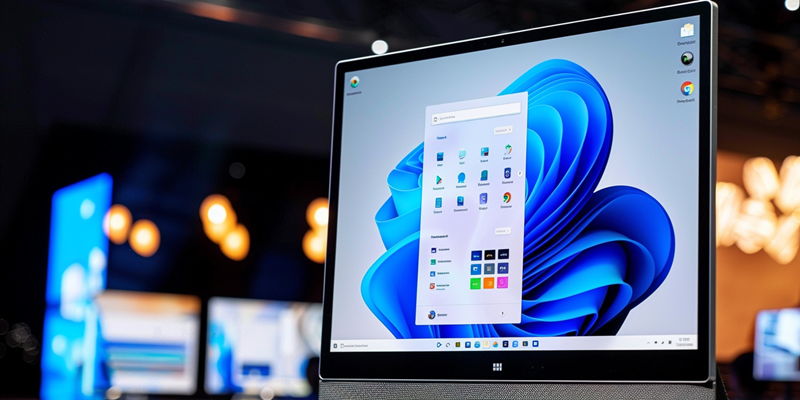The cutting-edge trajectory of AMD’s Ryzen AI 300 series processors ushers in a new era of compatibility strategy, singling out Windows 11 and various Linux distributions for exclusive driver support. The article explores the implications of AMD’s significant shift in OS alignment for its upcoming Strix Point laptops that will feature the Zen 5 architecture. Gone are the days where backward compatibility is the norm; a transformative wave within the tech giant suggests a full embrace of the newer, more sophisticated software ecosystems. As AMD gears up for release, users are poised on the cusp of a revamped computing horizon—one that promises to deliver unprecedented artificial intelligence capabilities.
AMD’s Strategic Move to Windows 11
The Ryzen AI 9 HX 370 specs page reveals AMD’s decision to abandon the widely-used Windows 10 in favor of offering driver support solely for Windows 11 and Linux OS. This paradigm shift reflects the processors’ advanced AI capabilities and the AI-focused vision of Windows 11. Advanced AI technologies have become the focal point of the next generation of computing. AMD’s Ryzen AI, with its cutting-edge NPU, exemplifies the industry’s move towards harnessing AI functionalities. The article discusses how Windows 11’s AI-centric features align with AMD’s innovative processors.
This pivot is informed by a clear acknowledgment of the software’s evolution to align with the burgeoning integration of AI. With advanced features like DirectStorage undergoing extensive revisions to better resonate with users’ aspirations, Windows 11 emerges not only as a new platform but as an AI-centric hub designed to unlock the full potential of AMD’s powerful NPU. It’s this synergy that leans into a future where AI is seamlessly entwined with every facet of our digital activity—a synergy that AMD intends to capitalize on, even if it means leaving some of its user base behind.
Embracing Newer Software Ecosystems
The move by AMD to exclude Windows 10 support marks a broader industry trend of prioritizing newer software ecosystems over legacy operating systems. This aligns hardware progress with modern software advances, where Windows 11 promises a more intuitive AI-driven user experience. While there is an acknowledgment of the minority user preference for legacy systems, the practicality and longevity of using the older systems are rapidly diminishing. AMD’s focus is firmly set on the future, aiming to optimize resource allocation and innovation by supporting the operating systems that fully utilize their hardware’s potential.
As technology continues to race ahead, the practical implications are stark: the ability to downgrade to Windows 10 will be challenged and potentially become unfeasible. AMD’s forward-facing strategy reflects a reality where maintaining dual compatibility is no longer efficient nor congruent with the tech titan’s ambition to spearhead AI advancements. Innovation and industry needs are propelling AMD and its users towards embracing newer, more capable software in what appears to be an inevitable and transformative shift in computing.
The Inevitability of Technological Progression
As the computing industry innovates, the phasing out of older technology becomes routine. AMD’s decision to forgo Windows 10 support is seen not as exclusionary but as part of the natural evolution of technology, especially given the nearing end-of-service for Windows 10 in 2025. The article emphasizes that the absence of Windows 10 support will have a negligible impact on most consumers, who will likely experience Ryzen AI processors in systems already equipped with Windows 11. The focus here is on the inevitability of progress within the technology industry and the seamless transition consumers can expect.
Moreover, this pivotal move by AMD could very well establish a precedent for other industry leaders to follow. By aligning with Windows 11, AMD sets a path shorn of the binds of legacy support—a path where innovation, led by AI, is both relentless and uncompromising. In this light, the landscape of compatibility isn’t just changing; it’s evolving to meet the demands of a future singularly defined by intelligence—both artificial and human. The Ryzen AI series isn’t just a product launch; it’s a statement about where the industry is headed and how AMD views its role in shaping that future.
Forward Compatibility: An Industry Imperative
AMD’s latest Ryzen AI 300 series processors mark a pivotal shift in technology, introducing a forward-focused compatibility approach that prioritizes Windows 11 and selected Linux distributions with exclusive driver support. The move, dissected in a recent article, showcases AMD’s strategy change as it aligns its soon-to-be-released Strix Point laptops, featuring the cutting-edge Zen 5 architecture, with emerging operating systems. This evolution signifies the end of an era for universal backward compatibility, signaling AMD’s commitment to advancing alongside modern, nuanced software environments. As the company prepares to launch these innovative processors, consumers stand at the dawn of a new computing frontier—one that’s expected to unleash groundbreaking artificial intelligence performance. This strategic realignment within AMD echoes a broader industry trend, wherein tech titans align themselves with the latest OS developments to unlock the full potential of their hardware innovations.

